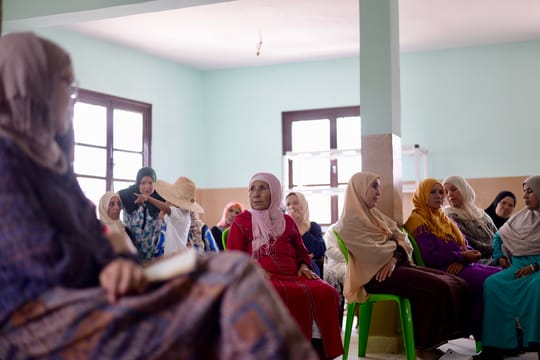Between Despondency and Hope in Morocco’s Oriental Region

– Between Despondency and Hope in Morocco’s Oriental Region, The Perspective, by Elle Houby (HAF writer), 29 January 2016.
– On the fringes of the Saharan desert, skirted by the rocky coastline of the northern Maghreb where it meets the blue Mediterranean, lies the Oriental region of Morocco. Nestling within an often verdant, predominantly mountainous terrain is Oujda, the largest city in the northeast of the Kingdom and the region’s administrative capital, with a population of around 550,000.
Oujda has known prosperity under a variety of rulers over the centuries, owing to its strategic location at the crossroads of an intricate web of trans-Saharan caravan routes, near the border with Algeria, and at the meeting point of the Moroccan and Algerian railway systems. In consequence, the city has developed a cosmopolitan, progressive, and adaptable character.
It remains a bustling metropolis despite hardship– the Rif is the most economically disadvantaged area of Morocco, with the closure of the Moroccan-Algerian border in 1994 making a particular impact. Since 2003, there has been official encouragement to revitalize the region; with the increase of tourism along the Kingdom’s northern coast, promising mineral deposits and agricultural prospects to the south, and the improvement of regional transport infrastructure, there is clear potential for Oujda’s economy to flourish.
Forests constitute one of the many local economic and natural resources, with the Rif region receiving more rainfall than any other in Morocco. Yet the ecology is endangered due to wide-scale deforestation that has taken place over the large century due to overgrazing, forest fires and land clearing for agriculture, particularly for the creation of illegal but highly lucrative cannabis plantations. The process is part of a vicious circle of soil degradation and the washing away of topsoil that not only threatens a unique area of the Kingdom but also has wider ramifications
Similarly, the youth of the Oujda Child Protection Center (OCPC) represent a microcosm of the potential for growth and opportunity and sadly, too, for the opposite not only in the Rif and in Morocco, but far beyond. The Middle East and North Africa region is home to the highest rate of youth unemployment in the world, but for the eighty young men, aged 12 to 18, who find themselves at OCPC, a new partnership with the High Atlas Foundation means growth and opportunity could be just on the horizon.
They find themselves at OCPC for a multitude of reasons, but share two things in common. “The children’s presence in protection center is court-ordered, as they have committed a felony punishable by law,” OCPC Director M. Ali Baidou explains. “However, they all desire to be reintegrated with the rest of the world, with access to the labor market to help themselves and their families.” To ensure that the youth of the center do not fall into harmful behavior patterns upon release, they require opportunities at OCPC to make time spent there, a more positive and productive experience.
Activities associated with the land, such as gardening, have long been appreciated for their therapeutic effects and incorporated into healing programs. Similar, progressive schemes are taking place in prison settings, with preliminary research indicating a clear correlation between participation in the program and a lower rate of recidivism. As well as plant raising, activities may include preparing and consuming the fruit and vegetables (resulting in an improved prison diet) or in a powerful and indeed potentially empowering form of social justice distributing them to local disadvantaged families, often with backgrounds similar to the prisoners’ own.
The transformative power of seeds is something that the High Atlas Foundation (HAF) knows well. Founded in 2000, HAF aims to be a catalyst for grassroots development in vulnerable communities throughout Morocco, by facilitating participatory development projects, of which one of the most commonly identified is fruit tree agriculture. Since its inception, HAF has planted over 1.3 million organic, indigenous fruit trees and medicinal plants in 13 Moroccan provinces. In 2014, it embarked on its One Billion Tree Campaign that embraces Sami’s Project, a junior educational initiative. As a whole, the scheme aims to support the Kingdom in its bid to overcome subsistence agriculture, which lies at the root of rural poverty, and to offset severe environmental challenges including soil erosion and deforestation.
In keeping with standard HAF practice, OCPC youth were fully involved from the outset, participating in community meetings under the aegis of HAF trained facilitators and deciding on a project that included vocational skills and agriculture. Through the establishment of a fruit tree nursery producing a total of 400,000 almond, fig, olive and pomegranate seeds, OCPC youth will learn the intricacies of arboriculture through the entire value chain from seeds to sales. In this way, they will be provided with an immediate outlet and tangible sense of accomplishment as well as an enhanced employment skill set in the long term.
Upon asking HAF President Dr. Yossef Ben Meir “why trees?”, the response contains an unmistakable passion, stemming from the conviction of experience. “Morocco needs to grow a billion trees and plants and to empower its disenfranchised youth. We can do both at once,” explains Ben Meir from HAF’s southern home base in the ochre city of Marrakesh. “Establishing nurseries at youth centers and equipping our young with the skills necessary to comprehend and participate in the entire agricultural value chain assures their best chance of a successful future and meets the essential needs of rural Moroccans.”
For the eighty young men at OCPC, an organic tree agriculture project in their backyard may not solve everything, but it’s a highly promising beginning. Further, if this pilot scheme, successfully implemented, were to be replicated on a national scale, it would have the capacity simultaneously to bring vital benefit to the economy and the ecology of the region and stimulate an unprecedented level of change among Moroccan youth, breaking through the outer husk of despondency and allowing hope to flourish and prevail.